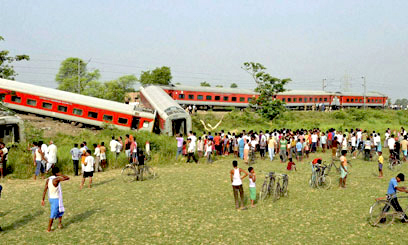Chapra (Bihar), Jun 25: At least four passengers were killed and eight injured when the Delhi-Dibrugarh Rajdhani Express derailed at Golden Ganj station near Chapra early today in suspected sabotage by Maoists.

12 coaches were derailed in the incident at around 0200 hours today, a Railway spokesperson said. Five coaches-B-1, B-2, B-3, B-4 and pantry car-overturned in the derailment while seven other coaches-B-5 to B-10 and power car-got derailed at the station, about 75 kms from Patna, he said.
Railways suspected sabotage by Maoists behind the derailment. "Prima facie, it appears to be a case of sabotage. There was a blast on the track, which could have caused the derailment," Railway Board Chairman Arunendra Kumar told PTI in Delhi.
"Another goods train, 60 kms away from the station, also got derailed due to a blast. 18 wagons got derailed in the accident," Kumar said.
The Maoists have given bandh call today to protest "strong armed" action by security forces against "innocent people" in the area on suspicion of being Maoists sympathiser.
Railway has ordered an enquiry to conducted by Commissioner Railway Safety, Eastern Circle to ascertain the cause of derailment.
Railway Minister Sadanand Gowda has announce ex-gratia of rupees 2 lakh for the family of each of the deceased, rupees one lakh for the grievously injured passengers and 20 thousand rupees for those with minor injuries.
While three passengers died on the spot, another succumbed to injuries in a hospital later, Chief Public Relation Officer of East Central Railway (ECR) Arvind Kumar Rajak said.
Gowda expressed grief over the loss of lives in the mishap. He directed the Railway administration to render best possible treatment to the injured passengers.
Railway minister Sadananda Gowda and Minister of State for Railway Manoj Sinha have rushed to the site along with Railway Board Member Traffic, D P Pandey and Member Mechanical, Alok Johri.
Gowda said in the case of the goods train derailment, it is a prima facie case of sabotage.
"As far as the Rajdhani derailment is concerned, investigations are on," the Railway Minister said.
Rajak said some of the coaches were hurled as far as 700 feet away from the track under the impact of the derailment.
Maoists are suspected to be behind the incident, he said.
However, the Saran district administration has ruled out Maoist role behind the Rajdhani Express derailment.
Saran District Magistrate Kundan Kumar said that the accident seems be due to operational problems and not triggered by Maoists.
He told reporters on the spot that another train Kaviguru Express had crossed the spot safely 15 minutes before Rajdhani Express.
Moreover, the place where the train derailed was not a secluded place but in a town which witnesses regular railway traffic. Hence any attempt of planting bombs or other activities of the Maoists could have been easily spotted, the DM said.
Kumar also said the casualty would have been higher, if it was an act of sabotage.
Saran Superintendent of Police Sudhir Kumar Singh also ruled out Maoist hand in the incident.
Maoists ultras had given a two-day bandh call in old Tirhut division comprising districts of Saran, Gopalganj and Siwan starting midnight last night.
Stranded passengers have been sent to Hajipur, headquarter of ECR, by a special train from where they would be sent on their onward journey, ECR CPRO said.
Lok Sabha MP from Saran Rajiv Pratap Rudy has reached the accident site to take stock of the relief operation.
Helplines have been set up to provide information to families of the victims and other passengers at Chapra, Samastipur, Hajipur, Sonpur, Barauni, Muzaffarpur, Lucknow, Varanasi, Balia, Guwahati, Dibrugarh, Tinsukia, Mariani, Dimapur, Lumding, New Coochbehar, New Jalpaiguri and Katihar.






Comments
Add new comment